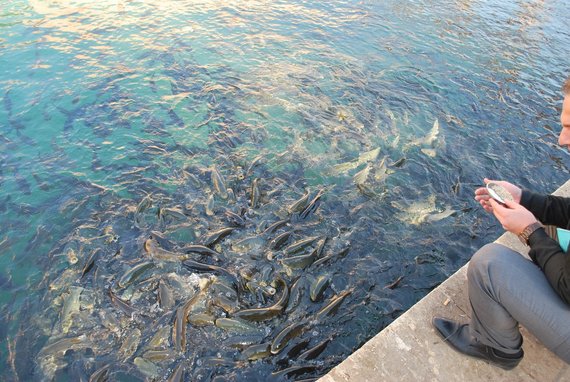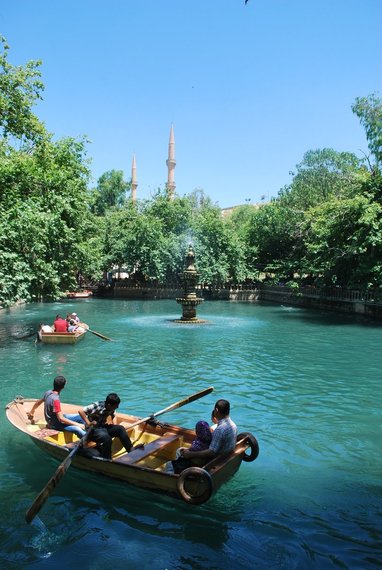The spiritual heart of Urfa is buzzing with tranquility. Each visitor here goes about his own peaceful business. This is our fifth day of exploring the Abraham Path and our first city walk of the journey; we take it slow. The places to see easily outnumber the few miles to walk.
In contrast to the last few days, here we are not alone. From sunrise to late after dawn, the Balikligol park is filled with slow wanderers, a mixture mostly of locals and Muslim pilgrims from further away. They stroll past the Fish Lakes, the rose gardens and the half dozen Mosques -- each of them built at a spot of Abraham's story in Islam. The secret birth of Abraham, and his hiding in a cave up to his seventh birthday. The challenge the young Abraham posed to the pagan-worshipping King Nemrut and the king's resolve to kill him. Nemrut's catapulting of Abraham from the cliffs overlooking the Balikligol into an enormous fire below, and the mysterious metamorphosis of the fire into water -- and the firewood, according to legend, into sacred carp. The solidarity of princess Zeliha, Nemrut's daughter, who jumped after Abraham, and whose flames also converted into water saving her from death.
Today, the two lakes commemorate Abraham and Zaliha's revolution against Nemrut, against polytheism and in favor of worshipping one single God. Both are overcrowded with large, enormous carp; their sacred status rendering them endless supplies of food by pilgrims. They have no enemies apart from their own appetite. On the Zaliha Lake, visitors can rent a small boat and row about the calm holy waters.
The tourism circus that has overtaken much religious heritage around the world is entirely absent here. We are left alone to our own impressions; free to wander and discover as we please. Pilgrims feed the obese carp, locals drink tea in the neatly kept gardens, and Turkish school groups visit Abraham's Birth Cave. Worshippers quietly enter and leave the Mosques that we visit. We can photograph anything. There are no minders. No special guardians. No tourism police. Some men swipe the plazas with brooms; others plant flowers in patches adjacent to a small madrasa.
On the streets of Urfa I hear Kurdish and Arabic. But all signs are in Turkish. English is virtually absent. Our upscale hotel at the edge of the park caters for all things we had to make do without in our homestays these past four days: private rooms and western-style toilets; a wireless connection and dinner at a table rather than cross-legged on the floor. There's even Efes available, Turkey's prime beer brand. But no English. Instead, we get shy smiles from the staff. The rooms are comfortable and quiet -- apart from a moment around 4 a.m. in the morning when the call for prayer from the four Mosques in the park reverberates against the massive rock on top of which sits Nimrod's Castle. Chanting follows. Abraham is revered even before the first rays of sunlight.
At the edge of the park I come across a campaign collecting donations for Syria. The pictures need no words, though Arabic and Turkish handwriting is all-present over white banners. To western visitors, the refugee crisis is not overtly present in Urfa, a city sixty kilometers north of the border, and relatively far from the camps managed by the Turkish government. Urfa is also a city that traditionally already has a mixed Arab, Kurdish and Turkish population. But we did notice UNHCR tents near the cotton fields in Harran yesterday, probably moved from their original set-up near the border as Syrians seek work on the plains of Harran. The day before that we met a man who had fled from Homs and was now living in the community of Kisas with his family. He had tried to do field work during the recent harvest, a hard fate for someone from a well-educated, middle-class background. The schooling of his children had stalled; they were trying to learn Turkish to proceed with their lives in a new land. These are but a few of the hard stories of this torn up region. We know them from the clinical daily news cycle. But they are harder and more real when you look them in the face.
For many these stories have become the single simple face of this region and the chief reason not to visit. They miss out on the other side of the story, the deep cultural and social fabric of the Middle East, the resonance of places such as Urfa, which for millennia has been at the crossroads of civilizations.
Barely a hundred yards from the banners on Syria, I pass the Mevlid-I Halil Mosque, the one commemorating Abraham's birth in this city. A sign in the far corner of its courtyard reads Hz. Ibrhim çorba evi, which means "Prophet Abraham's Soup House." A peek inside reveals a simple kitchen. This is an aşevi, a soup kitchen, which has been there since time immemorial, known to both hungry pilgrims and local people in need, serving them each morning without asking anything in return. The kitchen is literally a stone's throw from Abraham's Birth Cave. It reminds me of that other soup kitchen in the troubled city of Hebron about one thousand kilometers from here, and a stone's throw from Abraham's Burial Cave.
And so the path connects not only through footsteps, but also through the scent, sound and tastes of soup cooked and shared in Urfa and Hebron, and many places in between. The two kitchens symbolize a theme weaved across the stories about Abraham's journey, and about this region more broadly: that of compassion; compassion for travellers, for pilgrims; compassion for the stranger that wanders in.
Photography by David Landis, Joris van Winckel, and Stefan Szepesi





